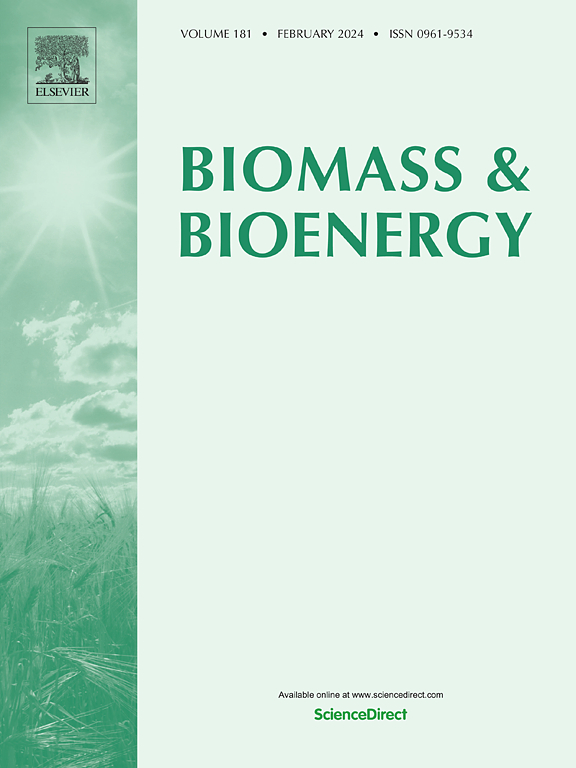Valorization of lignocellulosic biomass forest residues in quebec via the integrated hydropyrolysis and hydroconversion (IH2) technology: A review
IF 5.8
2区 生物学
Q1 AGRICULTURAL ENGINEERING
引用次数: 0
Abstract
Lignocellulosic biomass residues from Quebec's forests, such as branches and logging residues, can be thermochemically converted into hydrocarbons-rich renewable fuels, offering a sustainable alternative to fossil oil in transportation. Integrated Hydropyrolysis and Hydroconversion (IH2) has emerged as a promising biorefinery technology for transforming diverse biomass feedstocks into bio-oil with properties akin to petroleum, achieving approximately 45 % carbon conversion and 27 wt% bio-oil yield. Optimal conditions for catalytic fast hydropyrolysis (CFHP) include temperatures of 400–450 °C, hydrogen pressures of 20–30 bar, and biomass heating rates of 100–500 °C/min. For the catalytic hydroconversion (CHC) stage, lower temperatures of 250–400 °C with similar hydrogen pressures are beneficial. To enhance bio-oil quality and yield, feed particle sizes below 1 mm are recommended for enhanced heat transfer. While clean hydrogen for IH2 could be produced from electrolysis and biomass, an alternative co-CFHP process using hydrogen-rich bio-based solvents, UEO, and waste plastics can mitigate the need for external hydrogen, high pressures, and complex setups. This can be operated with or without an optional hydrotreatment stage based on required product specifications. The results highlight some potential catalyst alternatives to TMS like TMO, TMP, TMN, and TMC that could improve deoxygenation efficiency and reduce associated challenges. Carbonaceous supports like biochars can replace conventional Al2O3 and achieve better performance w.r.t coking, surface functionalities, metal dispersibility, and sensitivity to deoxygenation by-products. Additionally, fluidized bed reactors are suggested for their scalability and effectiveness in facilitating consistent reactions. Overall, this study underscores the viability of IH2 and identifies critical areas for further research to achieve demonstration-scale feasibility.
利用综合加氢热解和加氢转化(IH2)技术对魁北克木质纤维素生物质森林残留物的增值研究进展
来自魁北克森林的木质纤维素生物质残留物,如树枝和伐木残留物,可以通过热化学转化为富含碳氢化合物的可再生燃料,为交通运输提供了化石石油的可持续替代品。综合加氢热解和加氢转化(IH2)已经成为一种有前途的生物炼制技术,可以将各种生物质原料转化为具有类似石油性质的生物油,实现约45%的碳转化率和27%的生物油收率。催化快速加氢热解(CFHP)的最佳条件包括温度400-450°C,氢气压力20-30 bar,生物质加热速率100-500°C/min。对于催化加氢转化(CHC)阶段,250-400℃的较低温度和相似的氢压力是有益的。为了提高生物油的质量和产量,建议饲料颗粒尺寸小于1毫米,以增强传热。虽然IH2的清洁氢可以从电解和生物质中产生,但另一种使用富氢生物基溶剂、UEO和废塑料的co-CFHP工艺可以减轻对外部氢、高压和复杂设置的需求。根据所需的产品规格,可选配加氢处理级或不选配加氢处理级。研究结果强调了TMO、TMP、TMN和TMC等潜在的TMS催化剂替代品可以提高脱氧效率并减少相关挑战。像生物炭这样的碳质载体可以取代传统的Al2O3,并且在焦化、表面功能、金属分散性和对脱氧副产物的敏感性方面具有更好的性能。此外,流化床反应器因其可扩展性和促进一致反应的有效性而被推荐。总的来说,这项研究强调了IH2的可行性,并确定了进一步研究的关键领域,以实现示范规模的可行性。
本文章由计算机程序翻译,如有差异,请以英文原文为准。
求助全文
约1分钟内获得全文
求助全文
来源期刊

Biomass & Bioenergy
工程技术-能源与燃料
CiteScore
11.50
自引率
3.30%
发文量
258
审稿时长
60 days
期刊介绍:
Biomass & Bioenergy is an international journal publishing original research papers and short communications, review articles and case studies on biological resources, chemical and biological processes, and biomass products for new renewable sources of energy and materials.
The scope of the journal extends to the environmental, management and economic aspects of biomass and bioenergy.
Key areas covered by the journal:
• Biomass: sources, energy crop production processes, genetic improvements, composition. Please note that research on these biomass subjects must be linked directly to bioenergy generation.
• Biological Residues: residues/rests from agricultural production, forestry and plantations (palm, sugar etc), processing industries, and municipal sources (MSW). Papers on the use of biomass residues through innovative processes/technological novelty and/or consideration of feedstock/system sustainability (or unsustainability) are welcomed. However waste treatment processes and pollution control or mitigation which are only tangentially related to bioenergy are not in the scope of the journal, as they are more suited to publications in the environmental arena. Papers that describe conventional waste streams (ie well described in existing literature) that do not empirically address ''new'' added value from the process are not suitable for submission to the journal.
• Bioenergy Processes: fermentations, thermochemical conversions, liquid and gaseous fuels, and petrochemical substitutes
• Bioenergy Utilization: direct combustion, gasification, electricity production, chemical processes, and by-product remediation
• Biomass and the Environment: carbon cycle, the net energy efficiency of bioenergy systems, assessment of sustainability, and biodiversity issues.
 求助内容:
求助内容: 应助结果提醒方式:
应助结果提醒方式:


